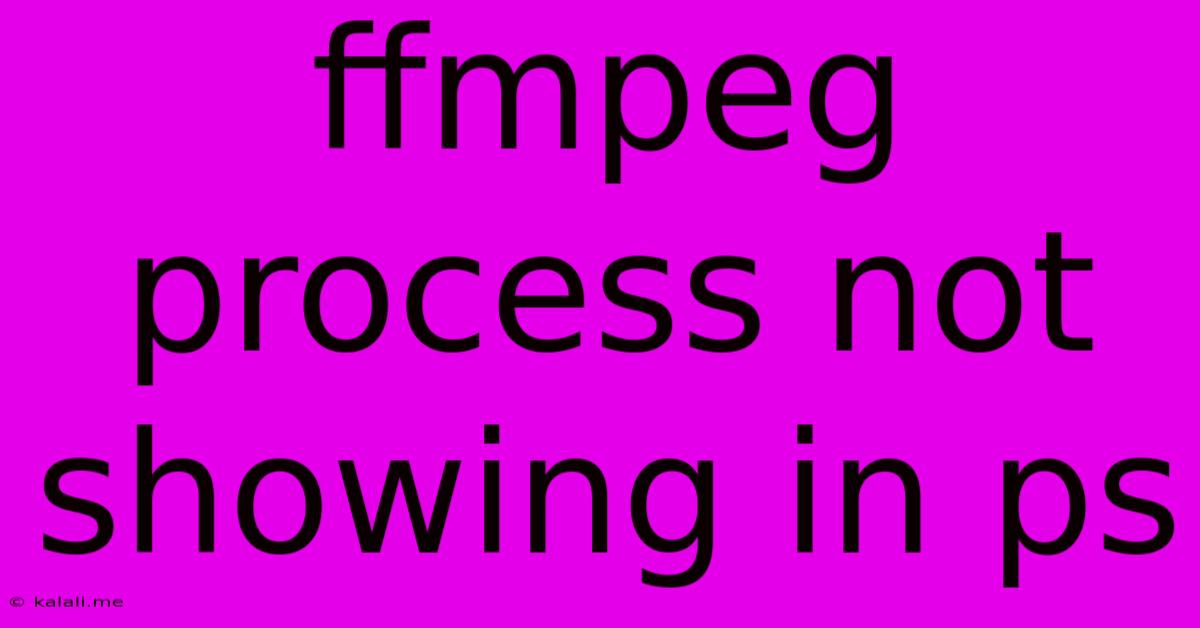Ffmpeg Process Not Showing In Ps
Kalali
Jun 01, 2025 · 3 min read

Table of Contents
FFmpeg Process Missing from ps Output: Troubleshooting Guide
Are you running an FFmpeg process, but it's nowhere to be found when you check using ps (or top, htop)? This frustrating issue can stem from several causes, and this guide will walk you through the most common culprits and their solutions. Understanding why your FFmpeg process is invisible to standard process monitoring tools is crucial for effective troubleshooting and maintaining smooth workflow.
Why isn't my FFmpeg process showing up?
The inability to see your FFmpeg process using standard commands like ps aux | grep ffmpeg often indicates the process is running in a less-obvious manner. This could be due to several factors:
-
Background Processes and Daemonization: FFmpeg can be run in the background using commands like
&or through more sophisticated methods likenohuporscreen. These detach the process from your current shell, making it invisible to standardpschecks unless you specify the correct options. -
Process Renaming or Masking: Some scripts or wrappers might rename or otherwise mask the FFmpeg process, making it harder to identify with simple
grepsearches. -
Privileges and User Context: The FFmpeg process might be running under a different user account than the one you're currently using, preventing you from seeing it with
ps. -
Crashing Processes: If FFmpeg crashed immediately after launching, it might not have registered with the system's process list before terminating.
Troubleshooting Steps: Finding Your Hidden FFmpeg Process
Let's tackle these potential issues systematically:
1. Comprehensive Process Listing:
Instead of ps aux | grep ffmpeg, try a more exhaustive command:
ps -ef | grep ffmpeg
The -f flag provides a fuller process listing, increasing the chances of finding your process even if it's partially hidden or renamed.
2. Checking Different User Contexts:
If you suspect the process is running under a different user, use sudo to check:
sudo ps -ef | grep ffmpeg
This requires administrator privileges, allowing you to see processes running under all user accounts.
3. Exploring Process Managers:
GUI-based process managers like htop or System Monitor (on many Linux distributions) often offer a richer view of running processes, making it easier to spot your FFmpeg process even if it's slightly disguised.
4. Investigating Background Processes:
If you ran FFmpeg in the background using &, check your process lists carefully. You might need to use jobs or fg commands to interact with background processes. If you used nohup or screen, you'll need to use the appropriate commands for those utilities to view and manage those background processes.
5. Inspecting System Logs:
If FFmpeg encountered errors during startup or execution, these errors might be logged. Checking system logs (usually located in /var/log/ directory) might reveal clues about why the process isn't running or is failing to register. Look for messages related to FFmpeg or its output file locations.
6. Checking for Process IDs:
If you launched FFmpeg and captured its Process ID (PID) at the time, use that PID directly with ps:
ps -p
Replace <PID> with the actual process ID.
7. Reviewing Your FFmpeg Command:
Double-check the command you used to launch FFmpeg. Ensure the command is correctly formed and the path to the FFmpeg executable is accurate. Incorrect commands might lead to immediate process termination before it can register.
8. Resource Exhaustion:
If the FFmpeg process is consuming excessive resources (CPU, memory, or disk I/O), it could potentially be terminated by the operating system before showing up in the process list. Monitor resource usage using tools like top or htop to identify any resource bottlenecks.
By systematically working through these troubleshooting steps, you should be able to locate your missing FFmpeg process and address any underlying issues causing its invisibility. Remember to always review your commands and consider the context under which your processes are launched.
Latest Posts
Latest Posts
-
The Database System Is In Recovery Mode
Jun 03, 2025
-
Export Out Audio From Voice Memos
Jun 03, 2025
-
Can You Eat The Seeds In Peppers
Jun 03, 2025
-
Can You Freeze Milk Kefir Grains
Jun 03, 2025
-
Difference Between A Burrito And An Enchilada
Jun 03, 2025
Related Post
Thank you for visiting our website which covers about Ffmpeg Process Not Showing In Ps . We hope the information provided has been useful to you. Feel free to contact us if you have any questions or need further assistance. See you next time and don't miss to bookmark.